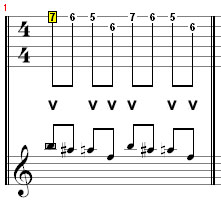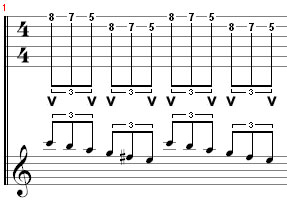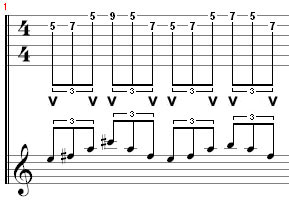The -v-v-
Contents
The -v-v- movement or how to play two consecutive downstrokes
This movement is probably one of the hardest to integrate and play naturally. Actually, one of the basic principles in Manouche guitar is to always use a downstroke when changing string, or to play important beats loud, which at first may seem counter-productive as far as speed is concerned. It's especially one of the toughest issues met by experienced guitarists with their share of "bad" habits. For the very least, playing downstrokes while sweeping strings downwards is still natural because it's common to all styles, Manouche inclusive. However, there's no such thing as upwards sweeping, and sometimes there is a need to make two consecutive downstrokes on the same string. At speedy tempos, this can become quite difficult and the wrist should be very innervated and muscled to make this gesture become smooth. Whatever you may try to find to justify the use of any non-Manouche technique to play Manouche, it is most probably wrong and you should persevere instead (I know, I did just that too).
Exercice 1
To get started with -v-v-, here's an exercise on the B string only (stroke note is D). on these videos, you can see that the arm does not move, the movement only comes from the wrist rotation.
Here's another exercise with string change for eigths 2 and 3.

|
Exercice 2
A variation on the same theme and again on two strings.

|
Exercice 3
Here's an example where -v-v- is used to stress the first note of a triplet without changing string. I'm not really good at it yet...

|




